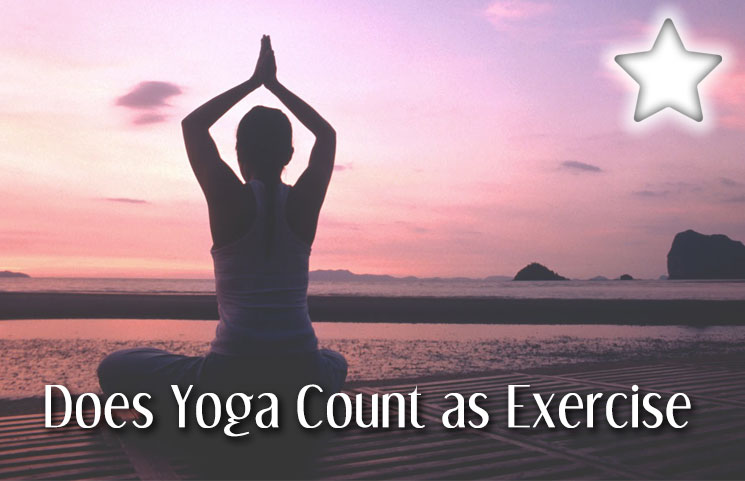If you are an athlete and are accustomed to rigorous exercises, then you might be one of the people who think yoga isn’t really an exercise. While you might be right partially, there is more to it than a simple “Yes” or “No” answer. Whether yoga should count as part of your recommended daily 30 minutes of exercise is all dependent on the type of yoga you are practicing.
There are many different types of yoga out there. Some are a bit more intense and others focus on concentration and meditation. However, this doesn’t mean yoga can’t count towards your 30 minutes of the suggested daily workout. The American College of Sports Medicine and the American Heart Association were the ones who set the guidelines for the recommendation of 30 minute daily exercise activity.
Recently they have done some research about a specific type of yoga known as hatha. They reviewed 17 different studies regarding the effects that this type of yoga has on our body. The verdict was that hatha yoga isn’t intense enough to offer sufficient enough cardio improving benefits. They classified hatha yoga as a lighter intensity style activity.
Should you still practice hatha yoga?
While it might be true that hatha yoga is more focused on a few calming and relaxing poses, this doesn’t mean that you should drop practicing this style and move on to something else. This style of yoga focuses on breathing, posture improvement, and meditation. There are plenty of benefits that you can derive from this yoga style. Let’s take a look at some benefits and see what hatha yoga can do for you.
Relaxes Mind and Body
One of the most focused on aspects of hatha yoga is breathing. You have to concentrate on proper breathing and use it to relax your body and mind. With time and practice, this will become natural. The best part is that using breathing to remove physical and mental stress sticks with you even when you aren’t practicing yoga. You can take breathing control anywhere and if you are ever in a tense situation, a few seconds of breathing properly and focusing on it can get you out of that taxing moment and get you back to positivity.
Flexibility
Increasing your flexibility can do amazing things for your body both long term and short term. However, the most typical way for doing this today has been through stretching your muscle fibers. The problem is that this doesn’t promote flexibility as much as you think it does.
Lean muscles do, in fact, help you improve your elasticity, but there are two other aspects of your body that can improve it even farther: the elasticity of connective tissues which bind your muscles and connect them to other organs, and your stretch reflex. Improving the connective tissues that encapsulate your muscles gives your muscles the capability to stretch farther by not restricting your muscles movements.
If your muscles are more elastic than the tissue which surrounds them, then they can’t stretch beyond the capabilities of that tissue. The same can be said for the tissues which connect the muscles to other organs; if your muscles are held back by less flexible connections to other organs then you can’t move as freely as you could if they were more flexible. The stretch reflex is also partially responsible for your elastic capabilities. Hatha yoga helps increase both of these flexibility indexes and that is exactly why it is so beneficial to improving your overall elasticity.
Spine Health
Your spine plays a huge role in your overall health. It allows your brain to communicate with literally every other organ in your body. All communication between your brain and your body goes through your spine. It should come as no surprise that if your spine becomes rigid and inflexible, then it can cause various damages to your organs’ health and even produce favorable conditions for an onset of chronic diseases.
Hatha yoga works to improve your spinal position and flexibility, which in turn increases the flow of communication between your brain and your organs. Unhindered nerve communications ensure that your body is functioning properly and your brain is doing everything it needs to do to make sure you stay healthy.
Improved Strength and Endurance
While hatha yoga is more relaxed and calming, it still promotes strength and endurance. Even though you aren’t switching from one pose to the next quickly and the poses themselves are easier to master, you are still controlling your body and using muscles to perfect each pose. Dedicating more time to a hatha routine will lead to increased strength and higher levels of endurance.
Balance
We tend to overlook this rather simple mechanic of our body and mind. Balance is absolutely crucial for proper body functions as well as mind stability. Hatha yoga works hard on improving and perfecting each pose, thus it ends up promoting your physical balance. The meditation and breath control side of hatha yoga works on improving your metal balance a swell. Combine the two together and you become well-rounded with great dexterity at your disposal and metal stability, able to withstand even the most stressful situations.
Hatha yoga isn’t for me, what are some more intense yoga styles?
If you decide that hatha yoga is too relaxing or you have been practicing it for a while and are ready to move on, then there are a few other, more intense yoga styles that you can take part in. Take a look at this short list of more physically demanding yoga styles
Ashtanga
If you are looking for fast-paced, sweat producing, and physically demanding yoga style, then ashtanga can definitely be the right choice. This yoga style focuses on six sequences of asanas (yoga poses) which go up in difficulty from one sequence to another. You will be able to learn at your own pace but be warned that these poses are not easy to master and will require exceptional control of your body and mind.
Iyengar
Speed and frequently changing poses aren’t the only ways to make your body work. Iyengar is a specific type of yoga dedicated to attention to detail. This means that you will be spending a lot of time perfecting every single stance and posture, especially the standing ones. While most yoga styles dedicate a short or moderate amount of time to each asana, iyengar has more to do with precision, which means you will be in a single pose for a very long time. Holding a long pose give you the ability to focus on every single muscle in your body as well as your skeletal posture. Often props are used during iyengar sessions to help improve certain muscles and structural imbalances or help those who might have injuries.
Bikram
You think your workouts at the gym make you sweat a lot? Wrong! Bikram style yoga will make you sweat more than you ever have before. This style of yoga is designed to be practiced in hot environments, sometimes pushing to as hot as 100oF. The idea behind increased temperature is simple, create a sauna-like effect to increase sweating and increased sweating will help you get rid of toxins much faster and more effectively. Usually, hatha poses are used in bikram yoga but the addition of sauna-like temperatures makes you sweat a lot more then you would regularly. All this sweat allows your body to supply fresh blood and oxygen circulation to your organs and extremities without any toxins involved.
Jivamukti
If you are interested in the spiritual aspect of yoga but also want to incorporate it into your recommended daily workout, then Jivamukti is definitely for you. It is a yoga style which is derived from an Ashtanga background and combined with a mixture of ancient and modern spiritual teachings. It demands physical capabilities but also focuses on chanting, meditation, reading, and music. Most starting classes will focus on perfecting stationary asanas and move onto more difficult poses which require more physical aptitude.
Final Words
So, does yoga count as exercise? It all depends on what style you choose and how deeply you are willing to commit your body and mind to yoga. Even if you decided to part take in the most difficult and intense yoga style, if you aren’t dedicated then the end result will be minuscule. Your mind controls everything you do and your automatic biological functions. This control might be subconscious but it is severely impacted by how you think. If you dive into the world of yoga with negativity then you won’t gain much out of it.
Yoga can be an excellent source of physical activity, but it can also be much more than that. If you let it, yoga can change your life. It can give you hope in places that seem dark and inescapable. It can give you faith and hope even in the darkest of times. However, you are the one who decides what you get out of yoga. In the end, it all depends on you.









